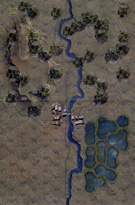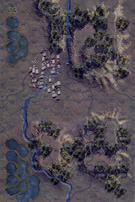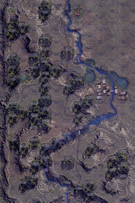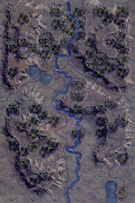|
Day Two, Taejon Flanked! Pusan Perimeter #28 |
||
|---|---|---|
| (Attacker) North Korea | vs | United States (Defender) |
| Formations Involved |
|---|

| Total | |
|---|---|
| Side 1 | 3 |
| Draw | 0 |
| Side 2 | 0 |
| Overall Rating, 3 votes |
|---|
|
4
|
| Scenario Rank: --- of 913 |
| Parent Game | Pusan Perimeter |
|---|---|
| Historicity | Historical |
| Date | 1950-07-20 |
| Start Time | 03:00 |
| Turn Count | 28 |
| Visibility | Day & Night |
| Counters | 133 |
| Net Morale | 1 |
| Net Initiative | 1 |
| Maps | 4: 92, 93, 94, 95 |
| Layout Dimensions | 43 x 28 cm 17 x 11 in |
| Play Bounty | 176 |
| AAR Bounty | 165 |
| Total Plays | 3 |
| Total AARs | 2 |
| Battle Types |
|---|
| Urban Assault |
| Conditions |
|---|
| Minefields |
| Off-board Artillery |
| Smoke |
| Illumination |
| Scenario Requirements & Playability | |
|---|---|
| Pusan Perimeter | Base Game |
| Introduction |
|---|
|
Without any artillery preparation to give away their intentions, the North Koreans struck the 1st Battalion of the 34th Regiment. Evidence of infiltration around the southern flank of the Taejon position had been either ignored or not reported, and the attack came as a complete surprise to Lt. Col. Ayres and his officers. NKPA troops were already within his perimeter by the time Ayres even knew he was under attack. |
| Conclusion |
|---|
|
When North Korean troops entered the American positions, many American soldiers dropped their weapons and ran. When North Korean tanks were reported entering the perimeter, Ayres dispatched bazooka teams with the brand-new 3.5-inch rocket launcher – just arrived at Taejon via emergency airlift - to deal with them. The experts sent along with the new bazookas claimed they could penetrate the armor of any tank, but Ayres’ crews never tested this proposition - they ran away, too. At some point Ayres’ staff abandoned their radio jeep, which the North Koreans used to inform regimental headquarters that all was well in 1st Battalion’s sector. |
| AFV Rules Pertaining to this Scenario's Order of Battle |
|---|
|
| Korean War: Pusan Perimeter, scenario #28: Day Two Taejon Flanked! | ||||||||||||
|---|---|---|---|---|---|---|---|---|---|---|---|---|
Korean War: Pusan Perimeter, scenario #28: Day Two Taejon Flanked! A big scenario with both sides trying to control the most town/village hexes on all four maps for the victory. The North Koreans have infiltrated the American lines in force and have to enter some units on all four maps while the disorganized American units must defend with some units on all four maps, not knowing where the NKPA units will enter but really the biggest prizes are on maps 92 and 93. Map 93 in fact has 11 town hexes out of the total of 22 so both attacker and defender will have to adjust units from the other maps and collide in the two major urban areas making some initial mobile actions as well as the urban combat. I’ll make a short AAR out of this longer but very interesting battle. I got greedy in my initial American setup, thinking I could defend 16 out of the 22 town/village hexes plus an on-board artillery park which cost me the game and gave the North Koreans the victory with a 13-9 town hex count. When I do it over again, I’ll pull back most the American units to defend on map 93 plus one or two town hexes on another map giving me a more concentrate force. The NKPA brought their units together to make two major forces and one minor one that took out the American artillery park first, so that they could dominate the battlefield with their off-board artillery. Three T-34/85 stacks can make a nice death star for adjacent American Infantry in town hexes and while those 75mm Jeeps can take nice pot shots but if they stick around too long, they disappear very fast. Also that M16 halftrack is feared by the NKPA infantry units but if you get careless with it as I did, the NKPA SU-76 popped a shot off eliminating half a step and sending the other half off demoralized never to really recover. Overall, a very good scenario to play, with a lot of options in setup, attack, defense, and overall strategies. Normally attacking American units in town hexes is not wise but with their morale at 7/5, there is a good chance either side could win this scenario. |
||||||||||||
| 0 Comments |
| Memories of Taejon | ||||||||||||
|---|---|---|---|---|---|---|---|---|---|---|---|---|
It has been a few years since I played this scenario but I still remember it vividly. The Americans set up the bulk of the infantry in the suburbs of map 93. A few smaller units held some of the satellite towns and villages. Single leaders with a platoon were placed in as many settlements as could be spared without compromising the main defense of Taejon. All positioned within range of US artillery. US long range artillery was dug into the tops of the highest surrounding hills and infantry was deployed alongside, dug into the slopes to defend against NK incursions. The first NK wave came from the North, masses of infantry began ascending the steep slopes towards the gun emplacements. US gunfire was heavy and combined with the artillery devastating, the NK first wave withdrew. Over the coming turns more NK amassed in the North and a second force now came from the south picking off some of the isolated villages along the trails, heading towards the open rice fields beyond. An Eastern NKPA contingent began manoeuvering itself along the banks of the river toward the nearest town. Unfortunately for the defends, artillery support was unavailable due to events closer to the gun batteries and so the NKPA managed to eventually reach Taejon relatively unmolested. US forces shifted from the Western to the Eastern side of the Taejon to receive the approaching force. It was at this point that the NK units in the North decided they had enough manpower to storm the nearest hill and take out the US gun emplacements. Within the hour the Americans on the hill were in disarray and eventually destroyed as a fighting unit. The US commander decided to detach a small force of some 40 men to engage the enemy by ferrying the men up the steep trails with trucks to take out the spotters. Fierce fighting broke out all across the horizon as dawn finally broke. With the US player now weakened in the town, the NK units began squeezing the last remaining units. T34s entered from the North and thrust straight towards the town. Some were knocked out on the river bridge by a few lucky bazooka rounds but the NK kept coming. It was around 8 in the morning when the US commander accepted defeat. The NK forces now held the hills overlooking the town, no cohesive US units existed within 2km of Taejon and the last of the US hilltop artillery fell silent as no leaders were left to assign targets. Taejon itself fell silent with T34s on its North bank and columns of NK troops entering from the South and East. A victory for the NKPA and a crushing defeat for the US. In hindsight the US placing its guns on the hills may not have been the best strategy BUT it did force the NKPA to deal with the threat from on high. The US players limited resources proved a challenge but this scenario is what gaming the Korean War is all about! |
||||||||||||
| 0 Comments |

 KWPP027
KWPP027 










































